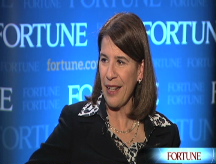Stocks snap 3-day losing streak
Dow rallies 552 points, an 870-point rebound from lows. Nasdaq and S&P 500 bounce from near 5-1/2 year lows.
NEW YORK (CNNMoney.com) -- Stocks surged Thursday, with the Dow posting its third best single-session point gain ever, as the major stock gauges bounced back from levels not seen since 2003.
The Dow Jones industrial average (INDU) added 552 points, after falling to within 81 points of its 5-1/2 year low earlier in the session. Between the close and the low, the Dow's swing was 870 points; it was 911 points between's the day's high and the day's low.
The Standard & Poor's 500 (SPX) index gained 6.9% and the Nasdaq composite (COMP) rose 6.5%. Both hit 5-1/2 year lows during the session before bouncing back.
Stocks had tumbled each day this week and through early Thursday afternoon. But the selloff left the major gauges at levels that many market pros think could represent a bear market bottom, at least in the near term.
After hitting those lows, stocks rebounded into positive territory.
"As soon as the Dow fell below 8,000, we saw a rush of buying," said Matt King, chief investment advisor at Bell Investment Advisors.
It was the second time the market "retested" those lows, which were first hit around Oct. 10. The major gauges slumped to around those levels at the end of October and now again in mid-November.
"It was very positive," King said of the big selloffs. "It seems like we have put a bottom in place."
However, he cautioned that because the two retests happened so rapidly, there's a possibility that the market could rally for a few months and then retest again. If so, that would be similar to what happened when the last bear market bottomed in 2002 and 2003.
Stocks have essentially fallen since Election Day. In the week ended Wed. Nov. 12, investors pulled roughly $31.8 billion out of equity mutual funds, according to tracking firm Trim Tabs. In the previous weeks, investors put roughly $2.2 billion into funds. Investors have cashed out of funds in 15 of the last 16 weeks amid the stock market selloff.
Rising oil prices helped Thursday's rally, giving a leg up to oil services stocks including Dow components Exxon Mobil (XOM, Fortune 500) and Chevron (CVX, Fortune 500). All but 2 of the Dow 30 rallied, with GM (GM, Fortune 500) and Citigroup (C, Fortune 500) the lone decliners.
Market breadth was positive. On the New York Stock Exchange, winners beat losers by almost three to one on volume of 1.99 billion shares. On the Nasdaq, advancers topped decliners by five to two on volume of 3.05 billion shares.
Economy: Stocks rallied despite a string of bad economic news.
The number of Americans filing new claims for unemployment last week rose to the highest level since just after the attacks of Sept. 11, 2001, the government reported. Additionally, the number of people continuing to file claims rose to a 25-year high.
"New claims for unemployment are kind of a leading indicator and they tend to foretell trouble," said Bryant Evans, portfolio manager at Cozad Asset Management.
And beyond the day-to-day reports, the outlook remains bleak, he said.
"I think we're seeing a direct consequence of a slowing macro economy, beyond the shorter-term problem of the credit markets," he said.
The September trade gap narrowed to $56.5 billion in October from $59.1 billion in August, as crude oil imports declined and the recession took a toll on exports.
Another report showed continued erosion in the housing market. Almost 85,000 homes were lost to foreclosure in October, according to a report from online tracking firm RealtyTrac. The report also showed that the number of homeowners receiving foreclosure filings rose 5% in October from the previous month and jumped 25% from a year ago.
RealtyTrac estimates that over 936,000 homes have been lost to foreclosure since August 2007.
And on Capitol Hill, lawmakers grilled executives at a Senate Banking Committee hearing. The head of the banking committee, Sen. Christopher Dodd, D-Conn., said banks getting cash as part of the $700 billion bank bailout have to start lending it out.
The House of Representatives held a hearing on regulation of the hedge fund industry.
In a sign of hope and optimism, a poll Thursday showed a majority of respondents think President-elect Barack Obama can improve the economy.
Company news: Wal-Mart Stores (WMT, Fortune 500) reported a higher third-quarter profit that beat estimates. However, the world's largest retailer also said that a stronger dollar would hurt its fourth-quarter and full-year profits. Shares rose 4.4% in the broader market advance.
Intel (INTC, Fortune 500) warned late Wednesday that its already sluggish fourth-quarter sales forecast won't hold up, with sales now expected to be even lower as chip demand continues to erode. Regardless, shares gained around 6.7%.
Chipmakers Applied Materials (AMAT, Fortune 500) and National Semiconductor (NSM) both warned that fiscal second-quarter sales won't meet forecasts, and announced job cuts. However, both stocks bounced with the rest of the market.
Citigroup cut profit forecasts on both Hewlett-Packard (HPQ, Fortune 500) and Dell (DELL, Fortune 500) due to a worldwide deterioration in demand for personal computers. HP shares gained, while Dell fell.
And GM continued to retreat with the Democrats and the Bush Administration at odds over whether the automakers should receive additional government support. Although some companies can use bankruptcy as a means of reorganizing and coming back stronger, for GM (GM, Fortune 500) that likely wouldn't work.
Other markets: In global trading, Asian markets tumbled, with Japan's Nikkei 225 down 5.3%. However, European markets ended mixed, with the London FTSE down 0.3% and the German DAX up 0.6%, even after a report showed that the German economy fell into recession.
The dollar gained against the euro and the yen.
COMEX gold for December delivery fell $13.30 to settle at $705 an ounce.
U.S. light crude oil for December delivery was up $2.08 to $58.24 a barrel on the New York Mercantile Exchange, cutting early gains after a government report showed crude inventories were flat last week but gasoline stockpiles rose more than expected. Oil closed at a 21-month low on Wednesday.
Gasoline prices dipped another 2.4 cents to a national average of $2.178 a gallon, according to a survey of credit-card activity released Thursday by motorist group AAA. The decline marks the 57th consecutive day that prices have decreased. During that time, prices dropped by $1.68 a gallon, or 43.5%.
Lending rates: The cost of borrowing rose modestly Thursday, but remained near recently improved levels.
The 3-month Libor rose to 2.15% from a four-year low of 2.13% Wednesday, according to Bloomberg.com. Overnight Libor rose to 0.4, up from 0.38% Wednesday, and up modestly from an all-time low of 0.32% last week. Libor is a key interbank lending rate.
The Libor-OIS spread, a measure of cash scarcity, fell to 1.61% from 1.71% Friday. The TED spread, a key indicator of risk, fell to 1.97% from 1.99% Monday.
The yield on the 3-month Treasury bill, seen as the safest place to put money in the short term, rose to 0.18% from 0.14% Wednesday, with investors preferring to take a small return on their money than risk the stock market. Last month, the 3-month yield reached a 68-year low around 0% as investor panic peaked.
Treasury prices tumbled, raising the yield on the benchmark 10-year note to 3.85% from 3.64% late Wednesday. Treasury prices and yields move in opposite directions. ![]()





